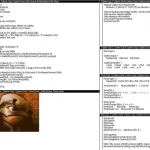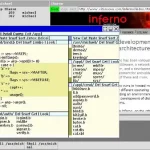Last Updated on: 24th July 2023, 03:50 pm
Web site: cs.vu.nl/pub/amoeba/
Origin: Netherlands
Category: Desktop
Desktop environment: CLI
Architecture: x86, MIPS, Motorola 68030, NS 32016, SUN 3/50 & 3/60, SPARC, VAX
Based on: Independent
Wikipedia: Amoeba_(operating_system)
Media: Install
The last version | Released: 5.3 | July 30, 1996
Amoeba – a fully functional operating system with shared time by Andrew S. Tannenbaum from Vrije University. The Amoeba distribution includes the source code, binaries and kernels for all supported architectures plus full on-line and Postscript versions of the documentation.
Amoeba is a powerful microkernel-based system that turns a collection of workstations or single-board computers into a transparent distributed system. It has been in use in academia, industry, and government for about 5 years. It runs on the SPARC (Sun4c and Sun4m), the 386/486, 68030, and Sun 3/50 and Sun 3/60.
Amoeba is a general-purpose distributed operating system. It is designed to take a collection of machines and make them act together as a single integrated system. In general, users are not aware of the number and location of the processors that run their commands, nor of the number and location of the file servers that store their files. To the casual user, an Amoeba system looks like a single old-fashioned time-sharing system.
Amoeba is an ongoing research project. It should be thought of as a platform for doing research and development in distributed and parallel systems, languages, protocols and applications. Although it provides some UNIX emulation, and has a definite UNIX-like flavor (including over 100 UNIX-like utilities), it is NOT a plug-compatible replacement for UNIX. It should be of interest to educators and researchers who want the source code of a distributed operating system to inspect and tinker with, as well as to those who need a base to run distributed and parallel applications. Amoeba is intended for both ‘‘distributed’’ computing (multiple independent users working on different projects) and ‘‘parallel’’ computing (e.g., one user using 50 CPUs to play chess in parallel). Amoeba provides the necessary mechanism for doing both distributed and parallel applications, but the policy is entirely determined by user-level programs. For example, both a traditional (i.e. sequential) ‘make’ and a new parallel ‘amake’ are supplied.





Gostaria de um tutorial de como baixar.